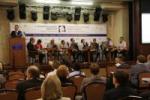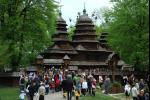- عربي
- Ukraine
- Economy
-
Investment
- Current Investment Trends
- Legal Conditions of Doing Business
- Investment Policy
- Competition
- Setting a Business in Ukraine
- Mergers and Acquisitions
- Taxation
- Import and Export
- Banks and Bank Regulation
- Convertibility and Profits Repatriation
- Currency Regulation
- Protection of Intellectual Property Rights
- Companies
- Travel to Ukraine
- About us
- Useful Sites
- Gallery
- News
Currency rates in UAH
| AED | ||
| BHD | ||
| EGP | ||
| KWD | ||
| LBP | ||
| OMR | ||
| QAR | ||
| SAR | ||
| SYP |
2015-07-06
| Kiev |  |
+32 |
| Donetsk |  |
+28 |
| Dnipropetrovsk |  |
+31 |
| Lviv |  |
+31 |
| Odessa |  |
+27 |
Kyivan Rus
In the year 882, it was stated in old chronicles that Oleg, the Prince of Novhorod, killed Prince Askold and Prince Dir and then mounted the Kyiv throne. He became the ruler of Kyiv or Old Rus, the first state of Old Slavs, which soon turned into one of the greatest countries of Medieval Europe. It played an important part in political life on the continent. It also served as a certain protective barrier between European civilization and the nomadic East. Kyiv became the capital of the state.
The poly-ethnical Old Rus state was a monarchical form of government. When he proclaimed Kyiv to be the political center of Rus, Prince Oleg (as well as his successors) was greatly concerned about the problem of the consolidation of the nearest tribal principalities around Kyiv. He was also concerned about the force of central state institutions being applied it its territory. All the East-Slav tribes and many non-Slav people were under dominion of the Kyiv Prince at the end of the 10th century. Kyiv Rus spread from the Black Sea to the White Sea, and from the Carpathians to the
The Prince's armed forces played the role of the state elite in Kyiv Rus until the early 11th century. Elder men at arms served as the Prince's advisers in the most important state affairs and occupied all administrative and court posts. During the reign of Yaroslav Mudriy (or Yaroslav the Wise) (1019-1054) the elder men performed only military functions. The administrative and legislative staffs were subject to boyars (old tribal aristocrats by birth).
Kyiv princes of the 9-10th centuries cared mainly about strengthening the economic and political power of the state. They fortified cities, put in order legal proceedings and a fiscal system, and regulated the obligations of the dependent population. During Princess Olga's reign (approximately 946), the first attempt was made to expel paganism and replace it with Christianity. Christianity wasn't officially introduced as a state religion in Rus until 988 by Prince Volodymyr Sviatoslavych. Diplomatic relations of the Old Rus State with the neighboring the countries of Byzanthia and the German Empire intensified during the mid-10th century after the fall of Khozar's state.
The military marches of Kyiv Princes played an important part in the expansion of the
The creation of the Old Rus nation state took place during the reign of Prince Sviatoslav's son, Prince Volodymyr (978-1015). The economical and political strength of the state, the authority of the Prince's rule, and the organization of law considerably increased during his reign. The successful military raids of the Prince expanded the limits of the Rus territory.
The process of forming the
It wasn't until the early 12th century that Volodymyr Monomakh (1113-1125) managed to stop these feuds for a while. It was under his reign that Kyiv's authority as the capital was once again increased, and the authority of the Kyiv Prince expanded to the major principalities and other princes. It was by his initiative that the convention of princes was called to decide important affairs and disputable issues. The internal and external position of the state was stabilized. This was the stage when all the characteristics of the medieval socio-political system with great feudal property, certain ideological, religious and political directions were established in Kyiv Rus.
From the 1130s the disintegration process of the
The period of feudal disintegration on the Old Rus lands not only set a mark on their political, socio-economic and cultural development, but also introduced certain innovations to geographical definitions of the state. In particular, the Kyiv Chronicle of 1187 had first coined the term "



